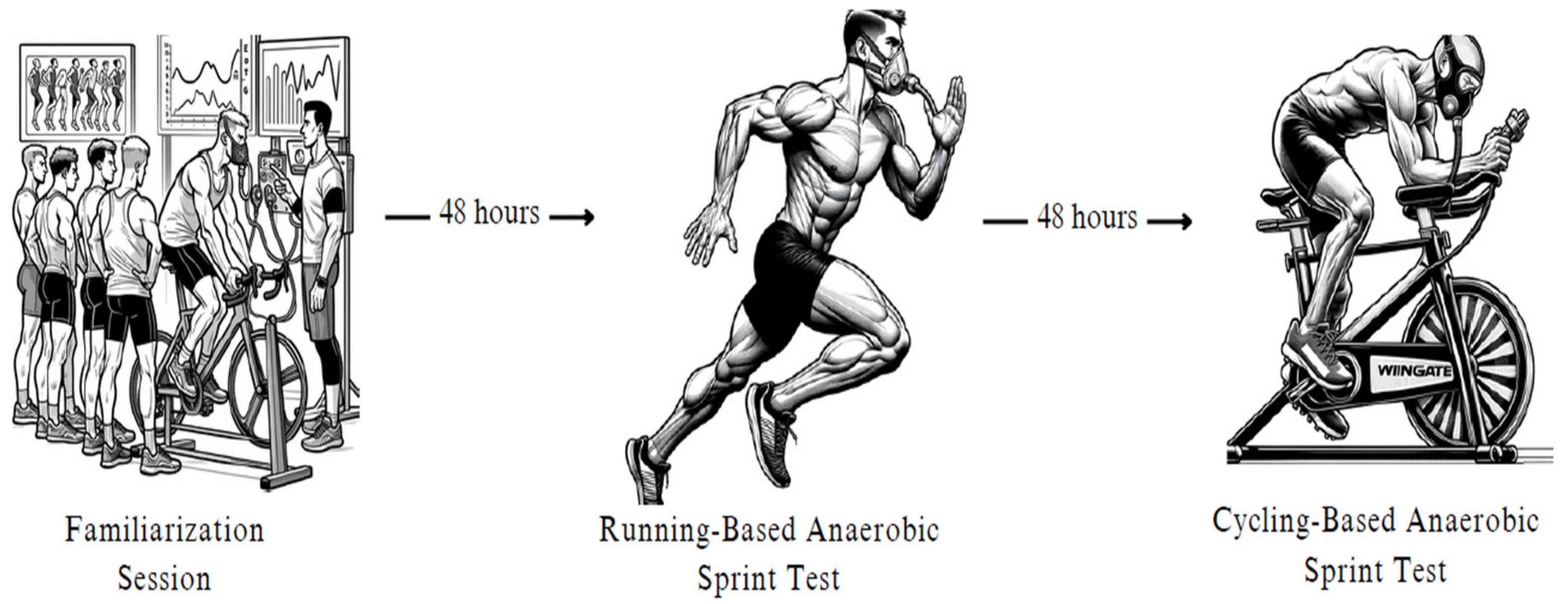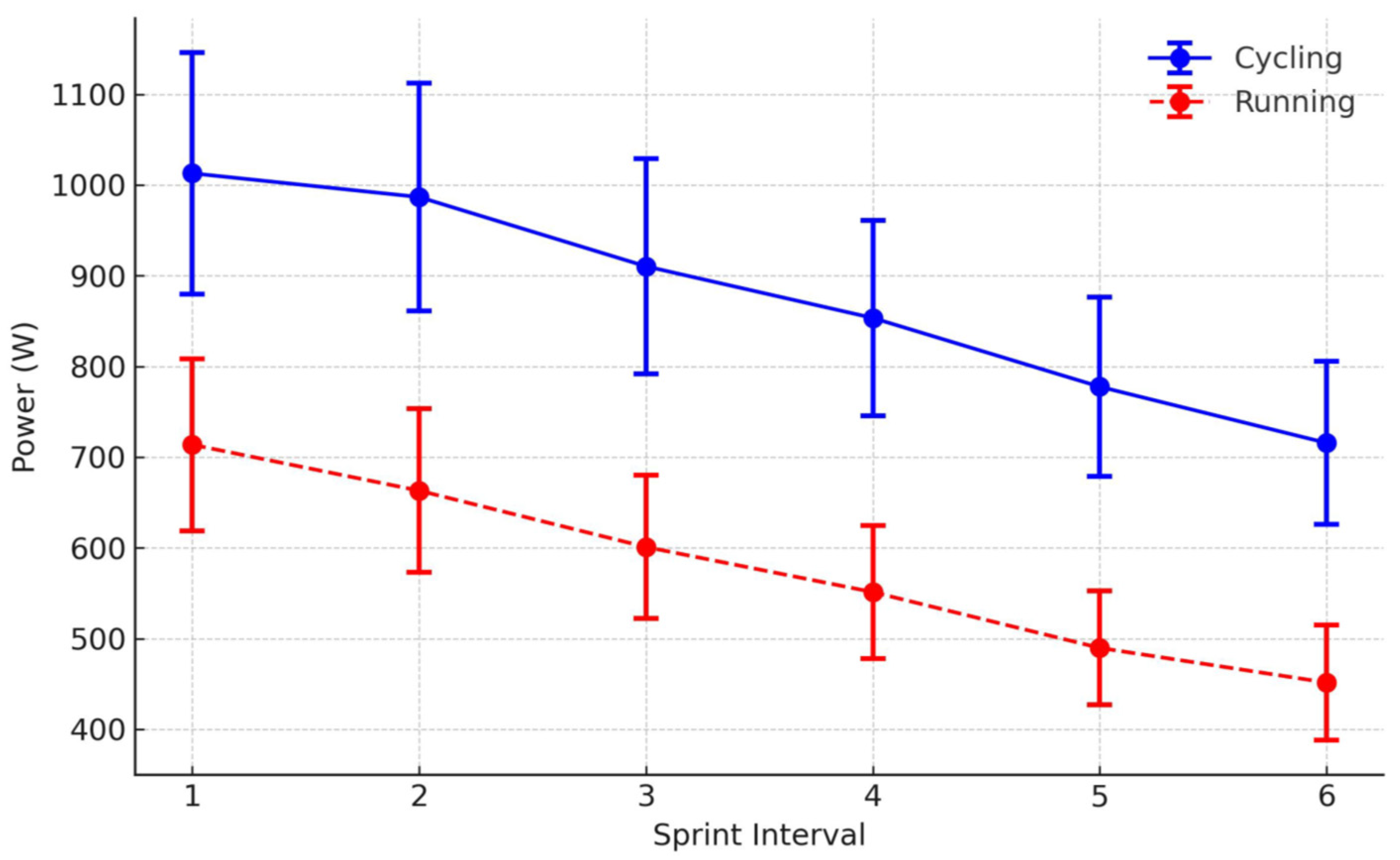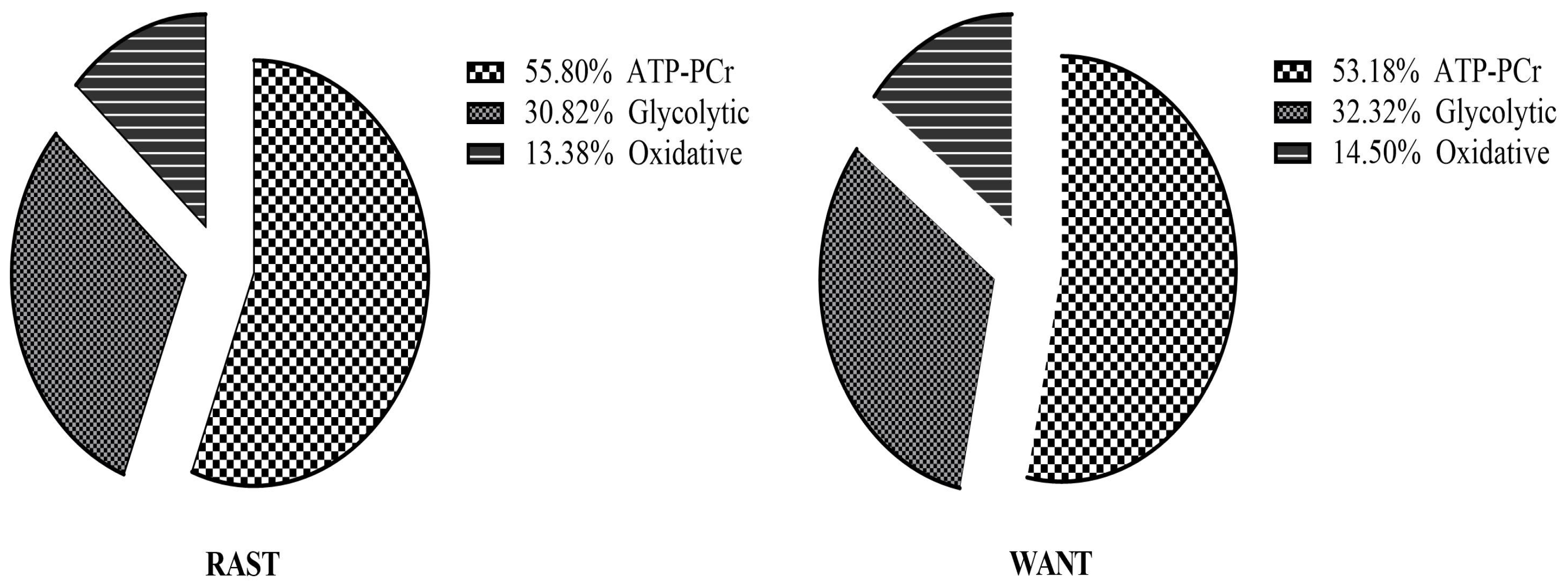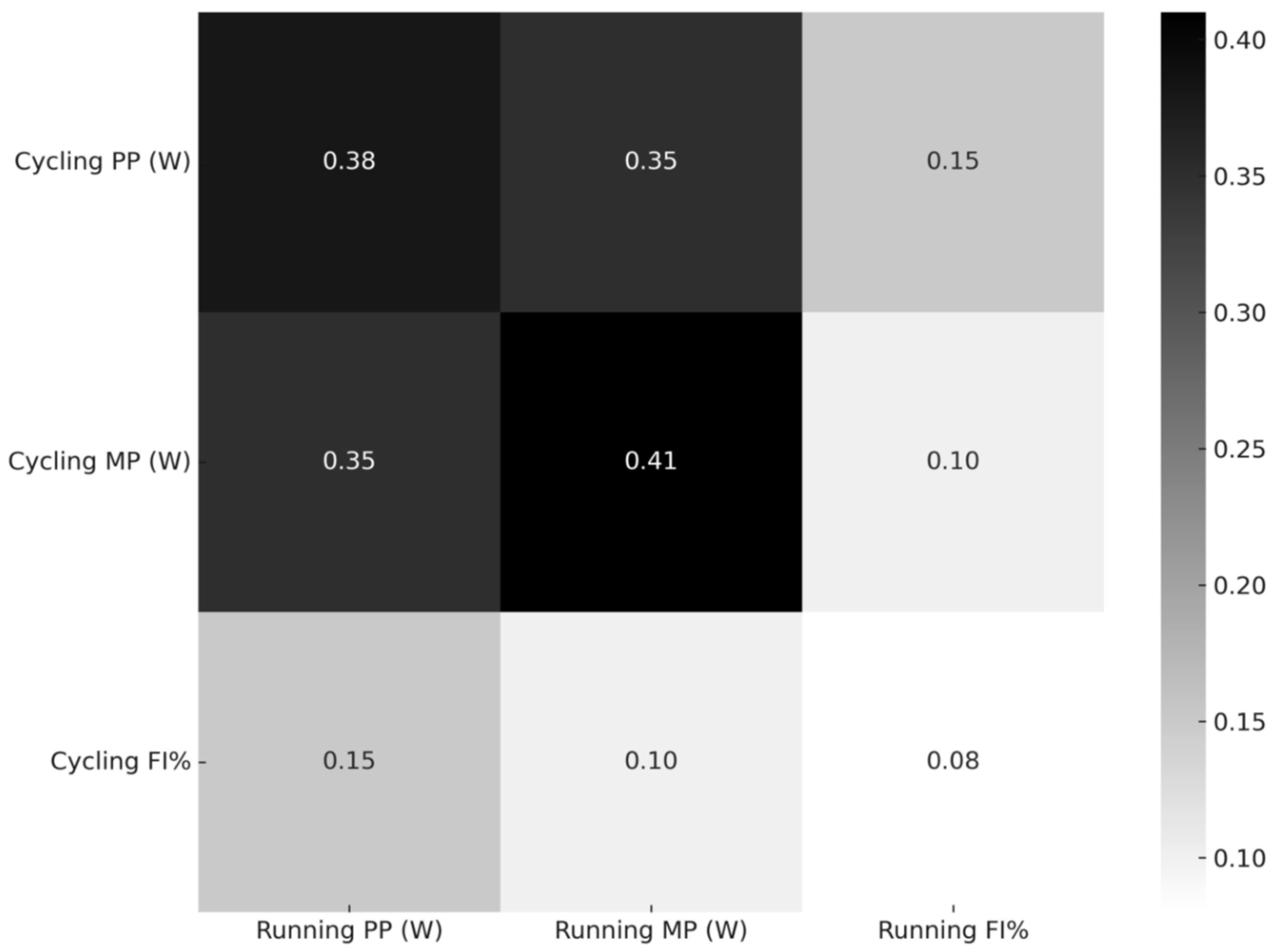Comparative Analysis of Energy System Demands and Performance Metrics in Professional Soccer Players: Running vs. Cycling Repeated Sprint Tests
Abstract
1. Introduction
2. Materials and Methods
2.1. Participants
2.2. Experimental Design
2.3. Running-Based Anaerobic Sprint Test (RAST)
2.4. Cycling-Based Anaerobic Sprint Test
2.5. Determination of Energy Demand and Energy Systems Contribution
2.6. Statistical Analysis
3. Results
4. Discussion
4.1. Performance Metrics Differences
4.2. Total Energy Expenditure (TEE)
4.3. Glycolytic Contribution
4.4. ATP-PCr Contribution
4.5. Oxidative Contribution
4.6. Rate of Perceived Exertion (RPE)
4.7. Associations between Energy Systems and Performance
4.8. Limitations
5. Conclusions
Author Contributions
Funding
Institutional Review Board Statement
Informed Consent Statement
Data Availability Statement
Acknowledgments
Conflicts of Interest
References
- Rodríguez-Fernández, A.; Sanchez-Sanchez, J.; Ramirez-Campillo, R.; Nakamura, F.Y.; Rodríguez-Marroyo, J.A.; Villa-Vicente, J.G. Relationship between repeated sprint ability, aerobic capacity, intermittent endurance, and heart rate recovery in youth soccer players. J. Strength Cond. Res. 2019, 33, 3406–3413. [Google Scholar] [CrossRef] [PubMed]
- Redkva, P.E.; Paes, M.R.; Fernandez, R.; da-Silva, S.G. Correlation between match performance and field tests in professional soccer players. J. Hum. Kinet. 2018, 62, 213. [Google Scholar] [CrossRef] [PubMed]
- Bradley, P.S.; Di Mascio, M.; Peart, D.; Olsen, P.; Sheldon, B. High-intensity activity profiles of elite soccer players at different performance levels. J. Strength Cond. Res. 2010, 24, 2343–2351. [Google Scholar] [CrossRef] [PubMed]
- Padulo, J.; Tabben, M.; Ardigò, L.; Ionel, M.; Popa, C.; Gevat, C.; Zagatto, A.; Iacono, A.D. Repeated sprint ability related to recovery time in young soccer players. Res. Sports Med. 2015, 23, 412–423. [Google Scholar] [CrossRef] [PubMed]
- Zagatto, A.M.; Beck, W.R.; Gobatto, C.A. Validity of the running anaerobic sprint test for assessing anaerobic power and predicting short-distance performances. J. Strength Cond. Res. 2009, 23, 1820–1827. [Google Scholar] [CrossRef] [PubMed]
- Zacharogiannis, E.; Paradisis, G.; Tziortzis, S. An evaluation of tests of anaerobic power and capacity. Med. Sci. Sports Exerc. 2004, 36, S116. [Google Scholar] [CrossRef]
- Fang, B.; Kim, Y.; Choi, M. Effect of cycle-based high-intensity interval training and moderate to moderate-intensity continuous training in adolescent soccer players. Healthcare 2021, 9, 1628. [Google Scholar] [CrossRef] [PubMed]
- Girard, O.; Mendez-Villanueva, A.; Bishop, D. Repeated-sprint ability-part I: Factors contributing to fatigue. Sports Med. 2011, 41, 673–694. [Google Scholar] [CrossRef] [PubMed]
- Spencer, M.; Bishop, D.; Dawson, B.; Goodman, C. Physiological and metabolic responses of repeated-sprint activities: Specific to field-based team sports. Sports Med. 2005, 35, 1025–1044. [Google Scholar] [CrossRef]
- Keir, D.A.; Thériault, F.; Serresse, O. Evaluation of the running-based anaerobic sprint test as a measure of repeated sprint ability in collegiate-level soccer players. J. Strength Cond. Res. 2013, 27, 1671–1678. [Google Scholar] [CrossRef]
- Brocherie, F.; Girard, O.; Forchino, F.; Al Haddad, H.; Dos Santos, G.A.; Millet, G.P. Relationships between anthropometric measures and athletic performance, with special reference to repeated-sprint ability, in the Qatar national soccer team. J. Sports Sci. 2014, 32, 1243–1254. [Google Scholar] [CrossRef]
- Milioni, F.; Zagatto, A.M.; Barbieri, R.A.; Andrade, V.L.; dos Santos, J.W.; Gobatto, C.A.; da Silva, A.S.R.; Santiago, P.R.P.; Papoti, M. Energy systems contribution in the running-based anaerobic sprint test. Int. J. Sports Med. 2017, 38, 226–232. [Google Scholar] [CrossRef]
- Nara, K.; Kumar, P.; Rathee, R.; Kumar, J. The compatibility of running-based anaerobic sprint test and Wingate anaerobic test: A systematic review and meta-analysis. Pedagog. Phys. Cult. Sports 2022, 26, 134–143. [Google Scholar] [CrossRef]
- Zagatto, A.; Redkva, P.; Loures, J.; Filho, C.K.; Franco, V.; Kaminagakura, E.; Papoti, M. Anaerobic contribution during maximal anaerobic running test: Correlation with maximal accumulated oxygen deficit. Scand. J. Med. Sci. Sports 2011, 21, e222–e230. [Google Scholar] [CrossRef]
- Chatterjee, S.; Chakraborty, S.; Chatterjee, S. Validity and reliability study of the running-based anaerobic sprint test for evaluating anaerobic power performance as compared to Wingate test in Indian male track and field sprinters. Eur. J. Phys. Educ. Sport Sci. 2022, 8. [Google Scholar] [CrossRef]
- Gaitanos, G.C.; Williams, C.; Boobis, L.H.; Brooks, S. Human muscle metabolism during intermittent maximal exercise. J. Appl. Physiol. 1993, 75, 712–719. [Google Scholar] [CrossRef] [PubMed]
- Bogdanis, G.C.; Nevill, M.E.; Boobis, L.H.; Lakomy, H.; Nevill, A.M. Recovery of power output and muscle metabolites following 30 s of maximal sprint cycling in man. J. Physiol. 1995, 482, 467–480. [Google Scholar] [CrossRef] [PubMed]
- Dawson, B.; Goodman, C.; Lawrence, S.; Preen, D.; Polglaze, T.; Fitzsimons, M.; Fournier, P. Muscle phosphocreatine repletion following single and repeated short sprint efforts. Scand. J. Med. Sci. Sports 1997, 7, 206–213. [Google Scholar] [CrossRef] [PubMed]
- Merrigan, J.J.; Stovall, J.H.; Stone, J.D.; Stephenson, M.; Finomore, V.S.; Hagen, J.A. Validation of Garmin and Polar devices for continuous heart rate monitoring during common training movements in tactical populations. Meas. Phys. Educ. Exerc. Sci. 2023, 27, 234–247. [Google Scholar] [CrossRef]
- Borg, G. Borg’s Perceived Exertion and Pain Scales: Human Kinetics; American Psychological Association: Champaign, IL, USA, 1998. [Google Scholar]
- Guidetti, L.; Meucci, M.; Bolletta, F.; Emerenziani, G.P.; Gallotta, M.C.; Baldari, C. Validity, reliability and minimum detectable change of COSMED K5 portable gas exchange system in breath-by-breath mode. PLoS ONE 2018, 13, e0209925. [Google Scholar] [CrossRef]
- Hart, S.; Drevets, K.; Alford, M.; Salacinski, A.; Hunt, B.E. A method-comparison study regarding the validity and reliability of the Lactate Plus analyzer. BMJ Open 2013, 3, e001899. [Google Scholar] [CrossRef] [PubMed]
- Andrade, V.; Zagatto, A.; Kalva-Filho, C.; Mendes, O.; Gobatto, C.; Campos, E.; Papoti, M. Running-based anaerobic sprint test as a procedure to evaluate anaerobic power. Int. J. Sports Med. 2015, 36, 1156–1162. [Google Scholar] [CrossRef] [PubMed]
- Deminice, R.; Rosa, F.T.; Franco, G.S.; Jordao, A.A.; de Freitas, E.C. Effects of creatine supplementation on oxidative stress and inflammatory markers after repeated-sprint exercise in humans. Nutrition 2013, 29, 1127–1132. [Google Scholar] [CrossRef] [PubMed]
- Bogdanis, G.; Papaspyrou, A.; Lakomy, H.; Nevill, M. Effects of inertia correction and resistive load on fatigue during repeated sprints on a friction-loaded cycle ergometer. J. Sports Sci. 2008, 26, 1437–1445. [Google Scholar] [CrossRef] [PubMed]
- Oliver, J.L. Is a fatigue index a worthwhile measure of repeated sprint ability? J. Sci. Med. Sport 2009, 12, 20–23. [Google Scholar] [CrossRef] [PubMed]
- Latzel, R.; Hoos, O.; Stier, S.; Kaufmann, S.; Fresz, V.; Reim, D.; Beneke, R. Energetic profile of the basketball exercise simulation test in junior elite players. Int. J. Sports Physiol. Perform. 2018, 13, 810–815. [Google Scholar] [CrossRef] [PubMed]
- Ulupınar, S.; Özbay, S.; Gençoğlu, C.; Franchini, E.; Kishalı, N.F.; Ince, I. Effects of sprint distance and repetition number on energy system contributions in soccer players. J. Exerc. Sci. Fit. 2021, 19, 182–188. [Google Scholar] [CrossRef] [PubMed]
- di Prampero, P.E.; Ferretti, G. The energetics of anaerobic muscle metabolism: A reappraisal of older and recent concepts. Respir. Physiol. 1999, 118, 103–115. [Google Scholar] [CrossRef] [PubMed]
- La Monica, M.B.; Fukuda, D.H.; Starling-Smith, T.M.; Clark, N.W.; Panissa, V.L. Alterations in energy system contribution following upper body sprint interval training. Eur. J. Appl. Physiol. 2020, 120, 643–651. [Google Scholar] [CrossRef]
- Julio, U.F.; Panissa, V.L.; Esteves, J.V.; Cury, R.L.; Agostinho, M.F.; Franchini, E. Energy-system contributions to simulated judo matches. Int. J. Sports Physiol. Perform. 2017, 12, 676–683. [Google Scholar] [CrossRef]
- Julio, U.F.; Panissa, V.L.; Cury, R.L.; Agostinho, M.F.; Esteves, J.V.; Franchini, E. Energy system contributions in upper and lower body wingate tests in highly trained athletes. Res. Q. Exerc. Sport 2019, 90, 244–250. [Google Scholar] [CrossRef]
- Franchini, E.; Sterkowicz, S.; Szmatlan-Gabrys, U.; Gabrys, T.; Garnys, M. Energy system contributions to the special judo fitness test. Int. J. Sports Physiol. Perform. 2011, 6, 334–343. [Google Scholar] [CrossRef] [PubMed]
- Gastin, P.B. Energy system interaction and relative contribution during maximal exercise. Sports Med. 2001, 31, 725–741. [Google Scholar] [CrossRef] [PubMed]
- Lakens, D. Calculating and reporting effect sizes to facilitate cumulative science: A practical primer for t-tests and ANOVAs. Front. Psychol. 2013, 4, 863. [Google Scholar] [CrossRef] [PubMed]
- Rampinini, E.; Connolly, D.R.; Ferioli, D.; La Torre, A.; Alberti, G.; Bosio, A. Peripheral neuromuscular fatigue induced by repeated-sprint exercise: Cycling vs. running. J. Sports Med. Phys. Fit. 2016, 56, 49–59. [Google Scholar]
- Millet, G.P.; Vleck, V.E.; Bentley, D.J. Physiological differences between cycling and running: Lessons from triathletes. Sports Med. 2009, 39, 179–206. [Google Scholar] [CrossRef] [PubMed]
- Bishop, D.J. Fatigue during intermittent-sprint exercise. Clin. Exp. Pharmacol. Physiol. 2012, 39, 836–841. [Google Scholar] [CrossRef] [PubMed]
- Özdemir, F.M.; Yılmaz, A.; Kinişler, A. Genç Futbolcularda Tekrarlı Sprint Performansının Yaşa Göre İncelenmesi. Spor Bilim. Derg. 2014, 25, 1–10. [Google Scholar]
- Twist, C.; Bott, R.; Highton, J. The physiological, perceptual and neuromuscular responses of team sport athletes to a running and cycling high intensity interval training session. Eur. J. Appl. Physiol. 2023, 123, 113–120. [Google Scholar] [CrossRef]
- Carter, H.; Jones, A.M.; Barstow, T.J.; Burnley, M.; Williams, C.A.; Doust, J.H. Oxygen uptake kinetics in treadmill running and cycle ergometry: A comparison. J. Appl. Physiol. 2000, 89, 899–907. [Google Scholar] [CrossRef]
- Hinrichs, R. A Three-Dimensional Analysis of the Net Moments at the Shoulder and Elbow Joints in Running and Their Relationship to Upper-Extremity EMG activity; Human Kinetics Publishers: Champaign, IL, USA, 1985. [Google Scholar]
- Jones, A.M.; McConnell, A.M. Effect of exercise modality on oxygen uptake kinetics during heavy exercise. Eur. J. Appl. Physiol. Occup. Physiol. 1999, 80, 213–219. [Google Scholar] [CrossRef] [PubMed]
- Beneke, R.; Pollmann, C.; Bleif, I.; Leithäuser, R.; Hütler, M. How anaerobic is the Wingate Anaerobic Test for humans? Eur. J. Appl. Physiol. 2002, 87, 388–392. [Google Scholar] [CrossRef] [PubMed]
- Little, T.; Williams, A.G. Effects of sprint duration and exercise: Rest ratio on repeated sprint performance and physiological responses in professional soccer players. J. Strength Cond. Res. 2007, 21, 646–648. [Google Scholar] [CrossRef] [PubMed]
- Ulupınar, S.; Özbay, S. Energy pathway contributions during 60-second upper-body Wingate test in Greco-Roman wrestlers: Intermittent versus single forms. Res. Sports Med. 2022, 30, 244–255. [Google Scholar] [CrossRef] [PubMed]
- Panissa, V.L.; Fukuda, D.H.; Caldeira, R.S.; Gerosa-Neto, J.; Lira, F.S.; Zagatto, A.M.; Franchini, E. Is oxygen uptake measurement enough to estimate energy expenditure during high-intensity intermittent exercise? Quantification of anaerobic contribution by different methods. Front. Physiol. 2018, 9, 868. [Google Scholar] [CrossRef] [PubMed]
- Davis, P.; Leithäuser, R.M.; Beneke, R. The energetics of semicontact 3× 2-min amateur boxing. Int. J. Sports Physiol. Perform. 2014, 9, 233–239. [Google Scholar] [CrossRef] [PubMed]
- Franchini, E. Response to Beneke and Hoos: Letters to the Editor. Int. J. Sports Physiol. Perform. 2012, 7, 308–309. [Google Scholar] [CrossRef]
- Bogdanis, G.; Nevill, M.; Lakomy, H.; Boobis, L. Power output and muscle metabolism during and following recovery from 10 and 20 s of maximal sprint exercise in humans. Acta Physiol. Scand. 1998, 163, 261–272. [Google Scholar] [CrossRef]
- Mendez-Villanueva, A.; Edge, J.; Suriano, R.; Hamer, P.; Bishop, D. The recovery of repeated-sprint exercise is associated with PCr resynthesis, while muscle pH and EMG amplitude remain depressed. PLoS ONE 2012, 7, e51977. [Google Scholar] [CrossRef]
- di Prampero, P.E.; Ferretti, G. The Energetics and Biomechanics of Walking and Running. In Exercise, Respiratory and Environmental Physiology: A Tribute from the School of Milano; Springer: Berlin/Heidelberg, Germany, 2023; pp. 133–170. [Google Scholar] [CrossRef]
- Bertuzzi, R.; Kiss, M.; Damasceno, M.; Oliveira, R.; Lima-Silva, A. Association between anaerobic components of the maximal accumulated oxygen deficit and 30-second Wingate test. Braz. J. Med. Biol. Res. 2015, 48, 261–266. [Google Scholar] [CrossRef]
- Wadley, G.; Le Rossignol, P. The relationship between repeated sprint ability and the aerobic and anaerobic energy systems. J. Sci. Med. Sport 1998, 1, 100–110. [Google Scholar] [CrossRef] [PubMed]




| Running Test (s) | Cycling Test (s) | |
|---|---|---|
| Sprint 1 | 4.98 ± 0.140 | 5.37 |
| Sprint 2 | 5.11 ± 0.150 | 5.37 |
| Sprint 3 | 5.28 ± 0.163 | 5.37 |
| Sprint 4 | 5.43 ± 0.139 | 5.37 |
| Sprint 5 | 5.64 ± 0.151 | 5.37 |
| Sprint 6 | 5.80 ± 0.192 | 5.37 |
| MST | 5.37 ± 0.312 | 5.37 |
| TST | 32.25 | 32.24 |
| Variables | Running Test | Cycling Test | Sprint Mode Effect | p | η2 |
|---|---|---|---|---|---|
| Peak power (W) | 713.7 ± 94.9 | 1012.9 ± 132.9 | F = 107.388 | 0.000 | 0.634 |
| Mean power (W) | 578.3 ± 72.1 | 876.1 ± 105.8 | F = 173.157 | 0.001 | 0.736 |
| Fİ (%) | 36.5 ± 6.6 | 30.0 ± 6.8 | F = 19.949 | 0.002 | 0.243 |
| Resting lactate (mmol·L−1) | 0.7 ± 0.2 | 0.8 ± 0.3 | F = 0.259 | 0.162 | 0.003 |
| Maximal lactate (mmol·L−1) | 15.4 ± 1.6 | 15.1 ± 1.5 | F = 0.560 | 0.133 | 0.251 |
| Lactate delta (mmol·L−1) | 14.7 ± 1.7 | 14.3 ± 1.6 | F = 0.561 | 0.102 | 0.011 |
| HR peak (bpm) | 176.3 ± 10.1 | 177 ± 6.7 | F = 0.241 | 0.159 | 0.009 |
| RPE | 13.4 ± 1.1 | 16.2 ± 1.4 | F = 10.456 | 0.000 | 0.345 |
| Variables | Running Test | Cycling Test | Sprint Mode Effect | p | η2 |
|---|---|---|---|---|---|
| ATP-PCr (%) | 55.8 ± 4.3 | 52.9 ± 2.9 | F = 9.982 | 0.002 | 0.137 |
| Glycolytic (%) | 30.8 ± 5.0 | 32.7 ± 3.6 | F = 2.922 | 0.092 | 0.044 |
| Oxidative (%) | 13.4 ± 2.4 | 14.5 ± 2.6 | F = 3.201 | 0.078 | 0.048 |
| ATP-PCr (kJ) | 108.9 ± 15.7 | 94.7 ± 12.2 | F = 15.460 | 0.000 | 0.200 |
| Glycolytic (kJ) | 61.1 ± 8.0 | 58.4 ± 8.5 | F = 1.769 | 0.188 | 0.028 |
| Oxidative (kJ) | 25.9 ± 5.5 | 26.0 ± 5.8 | F = 0.005 | 0.985 | 0.000 |
| Energy demand (L of O2) | 9.4 ± 1.0 | 8.6 ± 0.9 | F = 9.951 | 0.002 | 0.138 |
| TEE (kJ) | 195.7 ± 21.4 | 179.0 ± 20.9 | F = 9.983 | 0.002 | 0.139 |
| PCr_breaks (kJ) | 51.4 ± 6.3 | 45.8 ± 6.2 | F = 12.544 | 0.001 | 0.168 |
| PCr_epocfast (kJ) | 57.5 ± 11.9 | 48.8 ± 9.2 | F = 10.433 | 0.002 | 0.144 |
| Running Test | Cycling Test | |||
|---|---|---|---|---|
| R2 | p-Values | R2 | p-Values | |
| Peak Power (W) | ||||
| ATP-PCr (kJ) | 0.58 | 0.001 | 0.46 | 0.005 |
| Glycolytic (kJ) | 0.41 | 0.019 | 0.36 | 0.026 |
| Oxidative (kJ) | 0.31 | 0.078 | 0.29 | 0.081 |
| Mean Power (W) | ||||
| ATP-PCr (kJ) | 0.35 | 0.030 | 0.31 | 0.037 |
| Glycolytic (kJ) | 0.38 | 0.011 | 0.34 | 0.015 |
| Oxidative (kJ) | 0.33 | 0.051 | 0.28 | 0.053 |
| Fatigue index (%) | ||||
| ATP-PCr (kJ) | −0.14 | 0.027 | −0.11 | 0.035 |
| Glycolytic (kJ) | −0.18 | 0.010 | −0.14 | 0.015 |
| Oxidative (kJ) | −0.06 | 0.314 | −0.07 | 0.428 |
Disclaimer/Publisher’s Note: The statements, opinions and data contained in all publications are solely those of the individual author(s) and contributor(s) and not of MDPI and/or the editor(s). MDPI and/or the editor(s) disclaim responsibility for any injury to people or property resulting from any ideas, methods, instructions or products referred to in the content. |
© 2024 by the authors. Licensee MDPI, Basel, Switzerland. This article is an open access article distributed under the terms and conditions of the Creative Commons Attribution (CC BY) license (https://creativecommons.org/licenses/by/4.0/).
Share and Cite
Tortu, E.; Deliceoglu, G. Comparative Analysis of Energy System Demands and Performance Metrics in Professional Soccer Players: Running vs. Cycling Repeated Sprint Tests. Appl. Sci. 2024, 14, 6518. https://doi.org/10.3390/app14156518
Tortu E, Deliceoglu G. Comparative Analysis of Energy System Demands and Performance Metrics in Professional Soccer Players: Running vs. Cycling Repeated Sprint Tests. Applied Sciences. 2024; 14(15):6518. https://doi.org/10.3390/app14156518
Chicago/Turabian StyleTortu, Erkan, and Gökhan Deliceoglu. 2024. "Comparative Analysis of Energy System Demands and Performance Metrics in Professional Soccer Players: Running vs. Cycling Repeated Sprint Tests" Applied Sciences 14, no. 15: 6518. https://doi.org/10.3390/app14156518
APA StyleTortu, E., & Deliceoglu, G. (2024). Comparative Analysis of Energy System Demands and Performance Metrics in Professional Soccer Players: Running vs. Cycling Repeated Sprint Tests. Applied Sciences, 14(15), 6518. https://doi.org/10.3390/app14156518







